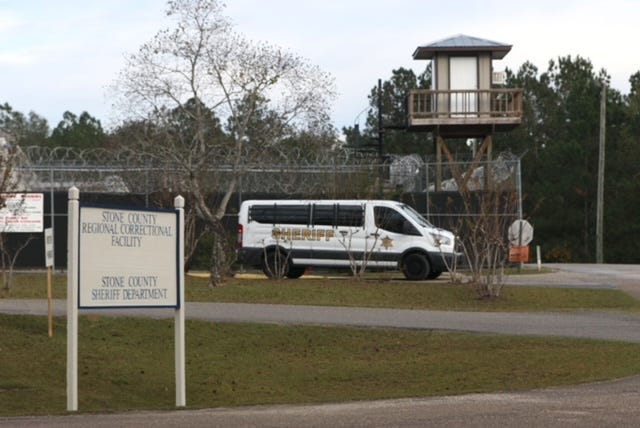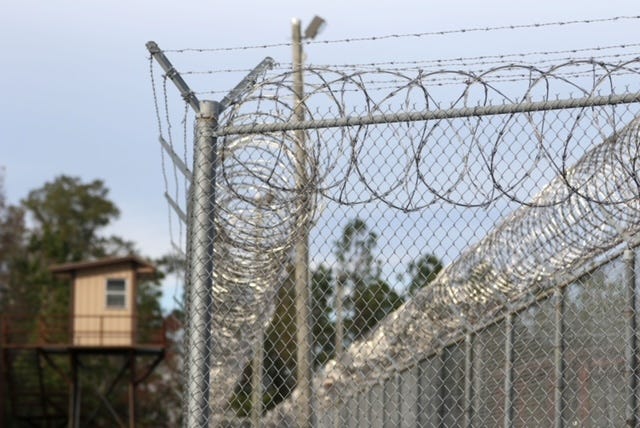Almost a year has passed since Harlene Blair of McHenry last saw her 21-year-old son Eli Marrero, alive. Now she wonders if she’ll ever find out why he died in law enforcement custody.
Blair told MCIR she was told her son was found hanging from a light fixture in his solitary confinement cell in the Stone County Correctional Facility on Jan. 29, 2022 — five months before his 22nd birthday.
Blair said her son’s case hasn’t gotten the attention it deserves from the investigators or the media. “I’m kind of afraid the police will mess with me if my name is printed, but I don’t care. I’ve called everybody from the TV stations and the newspapers all the way to the governor,” Blair said. “I’ve called fifty law firms — all of them said they’d have a conflict of interest since they have to work with police.”
Blair said her son was arrested at her home after Thanksgiving in 2021 for not reporting to his probation officer in relation to stealing a car. Blair said the car belonged to Marrero’s cousin, and Marrero’s defense was that he thought he had permission to drive it. Blair said she saw papers Marrero had received after his release, and she saw no mention of needing to report to anyone. She said her questions to the sheriff at his arrest were rebuffed.

“I asked them for the paperwork with the warrant, and they wouldn’t give me anything, and they wouldn’t let me hug him goodbye,” Blair said.
The sheriff would not respond to questions for comment.
Marrero suffered from schizophrenia, diagnosed at age 16. Blair said he received treatment at Gulf Coast Mental Health Center in Wiggins. She said she did not think Marrero was medicated while he was in jail, even though she said she told the sheriff’s department he needed his medication when they came to arrest him. “They sent two cop cars to come get him,” she said.
Attorney David Sullivan of Gulfport, who was Marrero’s public defender on the car theft charge, told MCIR that he didn’t understand why Marrero would have been arrested in the first place for not reporting to his probation officer. He said that in cases like that, police usually arrest a person as they encounter them in the community — not going out of their way to find him at home.
And even if he were sentenced on the charge, Marrero might have been credited with time served or even have gotten a second chance from the judge, Sullivan said. “He wasn’t looking at years in prison. He did that time because he couldn’t afford to bond out. He would have been parole-eligible anyway.”

He said Marrero was not entitled to a public defender for a probation violation charge so he was no longer involved in the young man’s defense.
Jail suicides on the rise
Jail suicides are becoming more common — 340 persons in state and federal prisons and 355 in local jails died by suicide in 2019, based on the most recent mortality data from the Bureau of Justice Statistics. The number of suicides in local jails increased 5% from 2018 to 2019, while suicides in state and federal prisons remained stable.
Suicides accounted for almost a third of deaths in local jails and 8% of deaths in state and federal prisons in 2019, according to the BJS. Nearly a fifth of the nation’s 1,161 state and federal prisons and a tenth of the 2,845 local jails had at least one suicide in 2019.
Over the 20-year period from 2000 to 2019, more than 6,200 local jail inmates died by suicide while in custody. Suicide deaths among jail inmates increased 13% over the period. Those who died by suicide were most often male, non-Hispanic white, incarcerated for a violent crime and died by self-strangulation.
More than three-quarters of jail inmates who died by suicide from 2000 to 2019 had not been convicted and were awaiting adjudication of their charge, according to the report.
The Mississippi Department of Mental Health is trying to get a handle on just how many prisoners in jails are battling mental illness, said Dr. Tom Recore, the head of forensic services for Mississippi since April 2022.

The department recently completed a year-long longitudinal study of just how long it takes for a mentally ill inmate to be ordered to have a competency hearing. The figures were stunning: inmates spent an average of 555 days in jail from the alleged offense until a judge ordered they be evaluated to see if they were competent to stand trial.
“The averages are high because of a handful of counties,” Recore explained.
Once the order was sent, it typically took another 191 days to process an inmate through a competency hearing, an evaluation period, and an order of noncompetency being entered. That amounted to 748 days — a little more than two years — according to the study.
Some of those inmates had been indicted for their crimes, and some had not — depending on when their cases were presented to a grand jury, which is the responsibility of the county, Recore noted.
One of the reasons that the first waiting period is so long is the inmates’ attorneys typically have to request a competency hearing, and Mississippi does not have a full-time public defender system in place. In Stone County, most public defenders are private attorneys from the Coast who do the work for $500 per inmate, Sullivan noted.
The Office of the State Public Defender was established in 2011 to unite various state agencies providing public defense under one umbrella and to develop proposals for a statewide public defender system. It issued its final report in 2018 to the Legislature, outlining a proposal for a statewide public defender system. The office’s annual report in 2021 shows that the implementation of the proposals is not complete, with the office proposing three pilot programs, one in each Supreme Court district, to be presented to the Legislature next year.
House Bill 360 to provide funding for these pilot programs passed the House in 2022 and died in the Senate Judiciary B Committee on March 1, 2022, according to the bill status website. The OPD’s 2022 annual report noted that efforts will be made to pass this pilot program in 2023.
A troubled man and problematic inmate
The Mississippi Bureau of Investigation, which has oversight over inmate deaths in the state, is investigating Marrero’s death. Because the investigation is ongoing, records of the case are unavailable under the state’s Open Records Act, according to Robert E. Wentworth, staff officer in Mississippi Department of Public Safety’s legal division.
But arrest records and incident reports obtained by MCIR paint a picture of a troubled man who became a problematic inmate.
According to his Dec. 2, 2021, interview, Marrero told booking officer Vickie Clark that he suffered from mental illness but did not receive treatment for it. He also said he had received treatment for substance abuse in the past, although it was not clear from those records where he received such treatment. His brief mental status exam at that time was deemed within normal limits.
During previous jail stays, Marrero had other incident reports — once for attempting to exit the jail through the fire escape door on the bay back to his lockdown cell after a court date in April 2021. Cpl. Aaron Lumpkin noted Marrero said God told him to go outside instead of to his cell. Attempts to get him into his cell resulted in an altercation between Lumpkin and Marrero, with two correctional officers assisting Lumpkin in getting Marrero into cell 135A, noted on Marrero’s transfer papers as a “suicide cell.”
Less than a month later, Marrero was the center of a multiple-inmate verbal altercation where other offenders accused Marrero of using racial slurs and of walking in on them during showers. As a result, Marrero was placed on lockdown without contact with any other prisoners, per Lumpkin’s report on the incident, or his mother.
On July 29, 2021, Marrero flooded his cell and other areas of the jail with “toilet water,” according to the report. He would not leave his cell when told to do so, resulting in Capt. Eddie Rogers, chief of security at Stone County Correctional Facility, spraying him with a one-second burst of pepper spray and a brief scuffle between them to get Marrero out of his cell, with six other officers in attendance, according to Lumpkin’s incident report.
Marrero lashed out at a particular inmate during his jail stays, identified in the records as Octavian Stanley — first on July 20, 2021, with the two shouting threats at each other, then, according to an affidavit filed on Dec. 29, 2021, alleging Marrero had jumped Stanley from behind and hit him in the head. An incident report from that day corroborates that Marrero had attacked Stanley while the inmate was cuffed. The scuffle resulted in a decision that the two should not be out of their cells at the same time for any reason.
Three days before his death on Jan. 25, 2022, Marrero was also written up for attempting to assault an officer. The officer noted that Marrero swung his handcuffed fists at the officer’s face. The officer blocked his swing and shoved him into his cell. According to the incident report, two other correctional officers witnessed the assault.
Blair confirmed Marrero, as a teenager, stayed in trouble at school because of problems with attention deficit disorder and got his GED after dropping out.
An April 24, 2017, article in the Biloxi Sun Herald quotes Capt. Ray Boggs as saying Marrero escaped from youth court after a hearing, possibly running off with his girlfriend who had a car waiting outside the building, injuring Chief Deputy Phyllis Olds.
‘This is not the place they need to be’
Marrero’s autopsy dated Feb. 1, 2022, which MCIR obtained from Blair, was signed by State Medical Examiner Dr. Staci Turner. It found ligature markings on Marrero’s neck, partially encircling it, which the examiner found consistent with the history given that Marrero had been found hanging in his cell. No spinal cord injury was present, nor were there any substances found in his body per the toxicology report. All other organs were normal with no evidence of natural disease.
Stone County Coroner Wayne Flurry said he was called to Memorial Hospital in Stone County, where Marrero had been taken in an effort to revive him. Flurry said he was told Marrero had been found hanging from a light fixture in his cell. Since Marrero had died in jail, the case was referred to MBI to investigate, and Marrero’s body was sent to the state Crime Lab for autopsy. “I referred it to the State Medical Examiner because all I had to go on was what I had been told,” Flurry said. “I did not go to the jail.”
Marrero’s case is not the first time Stone County Sheriff’s Department has been investigated for how it handled the mentally ill. In June 2019, Pablo de la Cruz, then a sheriff’s K-9 deputy, resigned amid an investigation into the alleged mistreatment of a mentally ill man picked up on a court order related to his health.
Blair said not knowing what exactly happened to her son was the most difficult part about his death. “Nobody would tell me anything,” she said. “Every time I asked why he was in solitary confinement, they said he’s not fit for general population.”
Rogers said it was known throughout the jail and the community that Marrero had problems. “One minute he was fine, the next minute you were like, what are you even saying? It would sound like he was speaking in Arabic,” Rogers said.
“It’s a sad situation,” Rogers said. “This is not the place they need to be. But I don’t know if Mississippi is ever going to do anything about it.”
Recore said the state is attempting to build a new system of services that quickly identifies mentally ill individuals in the prison system, gets them evaluated for competency, and gets them the necessary treatment they need to be restored to competency if possible — or kept in the least restrictive environment available if that’s not possible.
Blair said she feels like some simple measures could have kept her son alive. “I would like them to take the bedsheets out of solitary confinement and to keep a better eye on the people in there,” she said, noting her son should have been checked on every 30 minutes or so if he was at risk for suicide.
Wendy Bailey, executive director at the Department of Mental Health, said the state is attempting to provide a continuum of care with two pilot programs based out of Region 8 Mental Health in Brandon and Region 12 Pine Belt Mental Health to connect inmates with medical treatment earlier in their confinement.
She said anyone who is concerned with the mental health of inmates should familiarize themselves with these new programs. “If you have everybody at the table, all the advocates for care, we can create a system that Mississippi can be proud of,” Bailey said.
This story was produced by the Mississippi Center for Investigative Reporting, a nonprofit news organization that is exposing wrongdoing, educating and empowering Mississippians, and raising up the next generation of investigative reporters. Sign up for our newsletter.
Email Julie Whitehead at [email protected].

